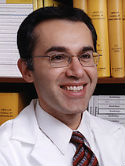Effects of covert and overt paradigms in clinical language fMRI Journal Article
| Authors: | Partovi, S.; Konrad, F.; Karimi, S.; Rengier, F.; Lyo, J. K.; Zipp, L.; Nennig, E.; Stippich, C. |
| Article Title: | Effects of covert and overt paradigms in clinical language fMRI |
| Abstract: | Rationale and Objectives: The aim of this study was to assess the intrasubject and intersubject reproducibility of functional magnetic resonance imaging (fMRI) language paradigms on language localization and lateralization. Materials and Methods: Fourteen healthy volunteers were enrolled prospectively and underwent language fMRI using visually triggered covert and overt sentence generation (SG) and word generation (WG) paradigms. Semiautomated analysis of all functional data was performed using Brain Voyager on an individual basis. Regions of interest for Broca's area, Wernicke's area, and their contralateral homologues were drawn. The Euclidean coordinates of the center of gravidity (x, y, and z) of the respective blood oxygenation level-dependent (BOLD) activation cluster, and the correlation of the measured hemodynamic response to the applied reference function (r), relative BOLD signal change as BOLD signal characteristics were measured in each region of interest. Regional lateralization indexes were calculated for Broca's area, Wernicke's area, and their contralateral homologues separately. Wilcoxon's signed-rank test was applied for statistical comparisons (P values < .05 were considered significant). Ten of the 14 volunteers had three repeated measurements to test intrasession reproducibility and intersession reproducibility. Results: Overall activation rates for the four paradigms were 89% for covert SG, 82% for overt SG, 89% for covert WG, and 100% for overt WG. When comparing covert and overt paradigms, language localization was significantly different in 17% (Euclidean coordinates) and 19% (BOLD signal characteristics), respectively. Language lateralization was significantly different in 75%. Intrasubject and intersubject reproducibility was excellent, with 3.3% significant differences among all five parameters for language localization and 0% significant differences for language lateralization using covert paradigms. Conclusions: Covert language paradigms (SG and WG) provided highly robust and reproducible localization and lateralization of essential language centers for scans performed on the same and different days. Their overt counterparts achieved confirmatory localization but lower lateralization capabilities. Reference data for presurgical application are provided. © 2012 AUR. |
| Keywords: | adult; middle aged; young adult; magnetic resonance imaging; sensitivity and specificity; reproducibility of results; brain; fmri; language; functional magnetic resonance imaging; hemispheric dominance; functional laterality; speech; normal human; human experiment; language processing; bold signal; diagonal band of broca; covert paradigm; overt paradigm; sentence generation; word generation; covert language paradigm; covert sentence generation paradigm; covert word generation paradigm; overt language paradigm; overt sentence generation paradigm; overt word generation paradigm; wernicke area; functional neuroimaging |
| Journal Title: | Academic Radiology |
| Volume: | 19 |
| Issue: | 5 |
| ISSN: | 1076-6332 |
| Publisher: | Elsevier Science, Inc. |
| Date Published: | 2012-05-01 |
| Start Page: | 518 |
| End Page: | 525 |
| Language: | English |
| DOI: | 10.1016/j.acra.2011.12.017 |
| PROVIDER: | scopus |
| PUBMED: | 22281389 |
| DOI/URL: | |
| Notes: | --- - "Export Date: 1 May 2012" - "CODEN: ARADF" - "Source: Scopus" |
Altmetric
Citation Impact
BMJ Impact Analytics
Related MSK Work




